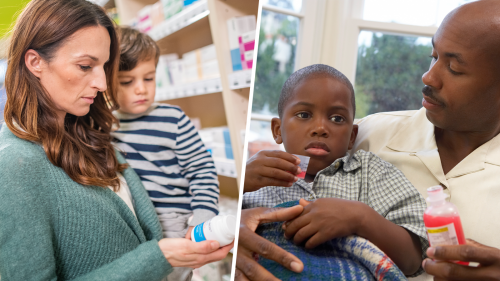Should You Give Kids Medicine for Coughs and Colds?

Although most colds in children don’t cause serious complications, they can cause stress and worry in parents and caregivers. It’s understandable that you might want to give your child medicine to treat a cold. But most children will get better on their own, and cough or cold medicine will not change the natural course of a cold or make it go away faster.
In addition, some cough and cold medicines can have serious side effects, such as slowed breathing, which can be life-threatening, especially in infants and young children. For those reasons, it’s important to know when your child needs medication, which treatments are recommended, and when to do without medicine.
These days, cold and cough symptoms can be especially worrisome, because they could be symptoms of COVID-19, the flu, or other potentially serious illness. If you are concerned about COVID-19, talk to your child’s health care provider.
Ways to Treat Colds in Infants and Children
Coughs are a normal symptom of a cold and help the body clear the mucus out of the airway and protect the lungs. Non-drug treatments for coughs include drinking plenty of fluids, especially warm drinks to soothe the throat.
The U.S. Food and Drug Administration offers these tips for relieving cough and cold symptoms in infants and children:
A cool mist humidifier makes breathing easier by decreasing congestion in nasal passages. Do not use warm mist humidifiers because they can cause nasal passages to swell and make breathing more difficult.
Saline nose drops or sprays keep nasal passages moist and help avoid stuffiness.
Nasal suctioning with a bulb syringe or a similar product, with or without saline nose drops, works very well for children younger than a year old. You can use them on older children, too, but they often resist bulb syringes.
Acetaminophen or ibuprofen can be used to reduce fever, aches, and pain. Carefully read and follow the product’s instructions on the Drug Facts label or talk to your pharmacist or health care provider about dosage.
Encourage children to drink plenty of liquids to stay hydrated.
Giving Children Cough and Cold Medicines
Over-the-counter (OTC) medicines are available to treat cough and cold symptoms. The FDA doesn’t recommend OTC medicines for cough and cold symptoms in children younger than 2 because they could cause serious and potentially life-threatening side effects. Manufacturers voluntarily label these cough and cold products to state: “Do not use in children under 4 years of age.”
Numerous OTC cough and cold products contain many ingredients that can lead to accidental overdosing. Learn about what drugs (active ingredients) are in a product by reading the Drug Facts label.
Nonprescription cough and cold products can be harmful to children if:
- They get more than the recommended dose or take the medicine too often.
- They take more than one product containing the same drug. For example, taking both a pain reliever containing acetaminophen and cough and cold medicine containing acetaminophen.
How can you be sure to give the correct dose? The FDA encourages drug manufacturers to provide a dosing instrument, such as a syringe or a cup, marked with the correct measurements. Use them—and not household spoons or tools from other medications—to measure medication.
Don’t give children medicines that are packaged and made for adults because adult medicines may overdose a child.
There Are No FDA-Approved Homeopathic Products
At your pharmacy and online, you may see other cough and cold medicine being sold for children advertised as homeopathic. It’s important to note that these homeopathic products are drugs because they are intended to treat or mitigate colds, even though some of these products might look similar to dietary supplements.
Homeopathic products are generally labeled as containing very small amounts of highly diluted substances, including ingredients from plants, animal or human sources, bacteria, minerals, and chemicals. The FDA has found that some of these products contain active drug ingredients in levels that far exceed the amount stated on the product’s label, and could cause significant harm to children.
There are no FDA-approved homeopathic products, and homeopathic products sold in the U.S. have not met the FDA’s requirements for safety and effectiveness. The FDA is not aware of any proven benefits of these products and urges you not to give homeopathic cough and cold medicine to children younger than 4.
In certain instances, children younger than 4 who took these products have experienced serious side effects, some of which required hospitalization, including:
- Seizure, allergic reaction, and difficulty breathing.
- Low blood potassium and low blood sugar, which may result in headache, crankiness, drowsiness, and weakness.
These serious side effects occurred soon after children took a homeopathic cough and cold product; however, it is not always possible to know whether a reported side effect was caused by a medicine.
When to Call a Doctor
Not every sniffle or cough merits a trip to the doctor’s office. When in doubt, call your health care provider.
Some symptoms can signal that your child may have something more serious than a cold. For all children, call a doctor if you see any of these symptoms:
- A fever of 100.4 degrees Fahrenheit or higher in an infant 2 months or younger.
- A fever of 102 degrees Fahrenheit or higher in children at any age.
- Blue lips.
- Labored breathing, including nostrils widening with each breath; wheezing; fast breathing; the ribs showing with each breath; or shortness of breath.
- Severe headache.
- Not eating or drinking, with signs of dehydration (such as decreased urination).
- Excessive crankiness or sleepiness.
- Persistent ear pain.
- If the child is getting worse.
